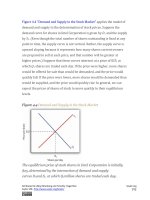Authors libby rittenberg 847
Bạn đang xem bản rút gọn của tài liệu. Xem và tải ngay bản đầy đủ của tài liệu tại đây (383.43 KB, 1 trang )
In addition to establishing the FTC, Congress enacted new antitrust laws
intended to strengthen the Sherman Act. The Clayton Act (1914) clarifies
the illegal per se provision of the Sherman Act by prohibiting the purchase
of a rival firm if the purchase would substantially decrease competition,
and outlawing interlocking directorates, in which there are the same
people sitting on the boards of directors of competing firms. More
significantly, the act prohibits price discrimination that is designed to
lessen competition or that tends to create a monopoly and exempts labor
unions from antitrust laws.
The Sherman and Clayton acts, like other early antitrust legislation, were
aimed at preventing mergers that reduce the number of firms in a single
industry. The consolidation of two or more producers of the same good or
service is called a horizontal merger. Such mergers increase concentration
and, therefore, the likelihood of collusion among the remaining firms.
The Celler–Kefauver Act of 1950 extended the antitrust provisions of
earlier legislation by blocking vertical mergers, which are mergers
between firms at different stages in the production and distribution of a
product if a reduction in competition will result. For example, the
acquisition by Ford Motor Company of a firm that supplies it with steel
would be a vertical merger.
U.S. Antitrust Policy Today
The “bigness is badness” doctrine dominated antitrust policy from 1945 to
the 1970s. But the doctrine always had its critics. If a firm is more efficient
than its competitors, why should it be punished? Critics of the antitrust
laws point to the fact that of the 500 largest companies in the United States
Attributed to Libby Rittenberg and Timothy Tregarthen
Saylor URL: />
Saylor.org
847









